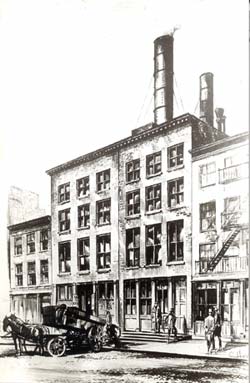Pearl Street Station facts for kids
Pearl Street Station was a very important place in history! It was the first power plant in the United States built by Thomas Edison. This plant made electricity for homes and businesses. It was located in New York City, on Pearl Street in an area called the Financial District. Thomas Edison's company, the Edison Illuminating Company, built it with the help of Francis Upton.
The Story of Pearl Street Station
The Pearl Street Station used coal to make electricity. It started with six large machines called dynamos. These machines could produce 100 kilowatts of power each. On September 4, 1882, the station began making electricity. It first powered 400 lamps for 82 customers. By 1884, it was serving 508 customers with over 10,000 lamps! The electricity it supplied was 110 volts DC (Direct Current).
At first, the station used special steam engines to power the dynamos. These engines were designed to be very fast. However, they were not very reliable and often had problems. So, they were replaced with new engines from a company called Armington & Sims. These new engines worked much better with Edison's dynamos.
Pearl Street Station provided electricity to an area called the "First District." This area was important because it was the world's first underground network for electricity. This means the power lines were hidden below the streets.
Sadly, the station caught fire in 1890. Most of it was destroyed, but one dynamo survived! This special dynamo is now kept in the Greenfield Village Museum in Dearborn, Michigan. The station was rebuilt after the fire. It continued to operate until 1895. By then, bigger and more efficient power plants had been built nearby, so Pearl Street Station was no longer needed.
Amazing Scale Models
In 1929, the Edison Company created three amazing working models of the Pearl Street Station. These models were built to a scale of one-half inch to one foot. They were quite large, about 62 inches long, 34 inches high, and 13 inches wide.
When you pushed a button on the model, a motor would turn the tiny engines and generators. This showed how the real station worked! Small lamps connected to buttons helped identify different parts of the building. You could also look inside the models through special cut-outs. This allowed you to see the boilers, steam engines, and dynamos.
It took about 31 people around six months to build these detailed models. Today, you can see these incredible models in a few places. One is at the Smithsonian Institution's National Museum of American History in Washington, D.C. Another is at the Consolidated Edison Learning Center in Long Island City, New York. The third is at The Henry Ford Museum in Dearborn, Michigan.
See also
- Holborn Viaduct power station
- Schuyler Wheeler
- War of the currents
- Schoellkopf Power Station - Direct current at Niagara Falls
- History of electric power transmission - California Electric Company develops the first US central power station in 1879


